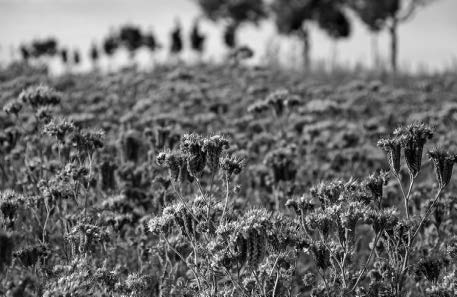CULTIVATE COVER CROPS
Once unwelcome plants, stones, and stumps have been removed, plant a restorative cover crop to outmaneuver the weeds that are ready to reclaim space. Be aware that eliminating established perennial weeds takes time because you must watch for eager new seedlings—and these tend to be numerous. First come perennial weeds and grasses like dandelions, milkweed, or burdock, followed by woody species: tree seedlings, exotic invaders such as Russian olives and Japanese barberries, and invasive brambles such as wild raspberries or thorny multiflora roses.
"It takes 2 or 3 years to clear overgrown space of unwanted plants and restore its ability to grow good vegetables," explains writer and home gardener Barbara Pleasant, who renovated several of her previously logged acres in Floyd, Virginia. "You'll be humbled by the number of weeds and thug plants that quickly come back to life."
Cover-cropping is especially important if your goal is field regeneration to establish an orchard or vineyard, grow vegetables or berries, or create habitats for wildlife. Animals from turtles to rabbits to bobolinks need edge-of-field native-plant habitats as well as open fields and thrive where there are wildflowers, hedges, nesting boxes, and small ponds.
Many plants work as soil-enriching cover crops. In spring or early fall, you might sow vigorous but controllable phacelia (aka leafy tansy) to form a dense carpet. It produces nectar-rich flowers when days are longer than 13 hours, and it's so beloved by bees that it's sometimes called Bee's Friend. Buckwheat is a good summer cover crop. Fast-growing mustard, best as a fall crop, likes a cool climate, as does winter rye. When these cover crops flower but before they go to seed, till them into the soil. They will provide a layer of mulch to feed the soil food web as they decompose.
To revive and revitalize hay fields, Van Hazinga plants cover crops of clover and timothy. "It's not a good idea to cut all of the hay in a field," he says. "Let the grasses build up a root reserve. Three or four cuttings a year, not giving the plants a chance to renew themselves, is what has exhausted old hayfields." It's much better, he says, to let the hay grow and allow the soil to develop bacteria, fungi, and microflora.
For his wheat fields, Van Hazinga's favorite cover crop is more wheat. "If you have tree stumps, rye is probably better, but it can cause roots to clump, and wheat is higher in nutrition. For growing vegetables, I'd definitely choose wheat.
"As far as cover crops go, everything depends on your circumstances, and they change so radically. You have to figure out what's best each time. You really can't reduce it to a science. This is why farming is an art."

PHACELIA
Photo: typo-graphics/Getty Images